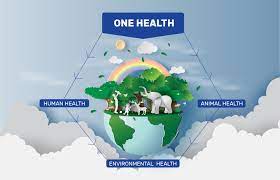One World- One Health: Prevent Zoonoses!
By- Diptesh Mishra
Bachelor of Veterinary Science and Animal Husbandry-1st Year
Institute of Veterinary Science and Animal Husbandry (IVS & AH)
SOA University
Bhubaneswar, Odisha -751030
Contact -7008904867
Mail- dipteshm0211@gmail.com

Abstract–
The transfer of diseases from animals to humans, called zoonoses, has been a common phenomenon. The recent pandemic Covid-19 created havoc challenging healthcare systems world-wide. As a result, the concept of ‘one world-one health’ has arisen as the most important goal for mankind. One world-one health, in practice, means taking care of every creature’s health on earth alike. Recently, a report published by Harvard Law School and New York University states that the USA can be home to the next pandemic. The unregulated meat market of the USA requires strict regulations for controlling zoonotic spillovers. Anthropogenic activities like deforestation, globalization, climate change, etc are also largely contributing to spread of zoonoses. The environment in which transmission of zoonoses takes place is key to understanding and controlling them. Changing lifestyles and adopting sustainable practices can keep the earth on motion for longer as united we stand and divided, we fall.
Keywords- Etiologic, Zoonotic spillovers, Sustenance, Climate change, Hygiene
Tembu, the tribal boy was shocked to see his father die out of an unknown disease. Govt officials in the town had called for a lockdown. People were asked to report and hand over their goats and pigs to the veterinarians who killed them mercilessly. For generations, Tembu’s family took care of the animals- both wild and domestic. Now when they were asked to surrender their animals, melancholy flooded into his family as well as his village. The people in the town kept blaming these animals, especially the pigs for the disease outbreak which Tembu was completely unaware of until his father’s death. The officials had rushed in when his father died and seized their domesticated pigs- his Snowy, his Smoky and all the other piglets that he played with. Tembu couldn’t get answers to any of his questions- why would they take away the animals? How did animals give birth to a disease which is killing millions of people? How would killing these animals provide a solution to all?
The transfer of diseases from animals to humans has been a common phenomenon. This is commonly called Zoonoses. A zoonosis is any disease or infection that is naturally transmissible from vertebrate animals to humans. There are over 200 known types of zoonoses. Zoonoses can be classified according to the etiologic agent- viral, bacterial, parasitic, mycotic, or unconventional(prions) [2]. Malaria, kala azar, plague, Avian influenza, Swine fever, Monkeypox, Mad cow disease, Hanta virus, etc have created havoc in human history. The most recent, covid-19 is also an example of zoonosis which remained as a pandemic for more than two years continuously and killed 1/10th of the entire human population.
Covid-19, which is supposed to have its origin in bats erupted in Wuhan city of China and travelled to the entire world in a couple of months creating havoc, challenging healthcare systems and collapsing govt across the world. The terror of this pandemic was so severe that the concept of ‘one world one health’ has arisen as the most important goal for mankind.
One world one health, in practice, means taking care of every creature’s health on earth alike. It is based on the understanding that humans, animals, and the environment are closely linked. Considering the interrelation between ecology, animal diseases and public health, we must strive to restore and maintain harmony between humans, animals and environment. Taking care of human health along with the health of the animals and ecosystem is the only way of sustenance right now.
The Wildlife Conservation Society (WCS) introduced the term ‘one world-one health’ in 2007 [2]. It is aimed at preventing epidemic disease and maintaining ecosystem integrity. With growing time, it was associated with all the health threats shared by people, animals and the environment. However, ‘one world-one health’ is not a new concept. It is ancient to Indian landmass. Scriptures and epics composed in India since the birth of human civilizations talked about caring for animals and the environment. India is widely known for its motto of Vasudhaiva Kutumbakam which means the world is one family. Even our Rig Veda calls upon us to take care of all animals. Not only in India, religions all across the world teach people to live in harmony with animals and the environment. Eminent personalities like Bertrand Russel have warned humans to be compassionate about other animals with his famous quote, ‘Its coexistence or no existence’ meaning man can never survive as a single species.
Mother Earth is said to have two baby species- the animals and the humans. Even humans are animals but their superior knowledge, ability to have command over resources and intellectual quotient have made them the superior one. These two siblings are highly dependent on each other and on their mother for survival. When the greed of man endangers survival of animals, it ultimately results in an imbalance in the earth’s family. And we are well aware of the fact that a broken family never survives! Hence, in order to have balance in nature, we must take care of our fellow animals. They make the place better and easier. There is no other way to protect mother earth. In the words of Ban Ki Moon, ‘There can be no plan B because there is no planet B’
Humans, animals and the environment- The trio!
Life has been possible on Earth because of the interaction between the Trio. The interaction between these three is unique and intermingled. Any harm to one would have deadly repercussions on others. Many a time, we have noticed disease in animals have affected humans largely. Similarly, destruction of the environment affects the balance in human lives. With the realization of these ideas, many environmentalists and intellectuals have come forward to advocate for environmental protection. However, there has been lesser awareness concerning man-animal relations and zoonoses.
Man, and animals are on earth for more than 200000 years. Primitive men used to pray to the animals and live in harmony with them. And we had no sign of zoonoses. Growing time and changing climate gave birth to complex phenomena like zoonoses. Diseases among animals are as natural as diseases among humans. However, zoonoses are dangerous. Scientists around the world have shown their concern for the prevention of zoonoses. One world-one health manifests one such concern.
Behind Zoonoses
In the last two decades, the world has witnessed a rapid increase in zoonotic disease outbreaks. Zoonoses or Zoonotic spillovers can happen through direct contact with infected animals or through vectors like teaks, mosquitoes, flies, etc. Though zoonotic diseases occur naturally, the recent increase in zoonotic disease spillovers can be attributed to several factors. These are the result of rapid human expansion and increased contact between humans and animals. The primary factor is the meat industry. A 2020 report shows that 44 out of 60 of the world’s largest meat, fish and dairy companies are considered high risk for zoonotic spillover events. The meat demand across the world in the last 40 years has quadrupled. Factory farms have been created in order to meet the demand [1]. Animals are kept here in crowds with poor ventilation and lack of sunlight which create a suitable environment for the growth of viruses and bacteria. They infect the animals and jump to the workers due to close contact resulting in spread among humans at a greater scale.
Recently, a report published by Harvard Law School and New York University states that the USA can be home to the next pandemic. One of the writers of the report, Ann Linder opines that the worsening living condition of animals in US farms and its lax laws will be the reason behind the pandemic. The unregulated meat market of the USA requires strict regulations for controlling zoonotic spillovers.
Moreover, deeper research has revealed that anthropogenic activities like deforestation, urbanization, globalization, climate change, global warming, etc are largely contributing to spread of zoonoses. In addition, social factors like poverty and poor education are also indirectly contributing to zoonotic spillovers.
Though anyone can have a zoonotic disease, children younger than five years, adults over sixty-five years, pregnant women and people with weakened immune systems are more susceptible to zoonotic diseases.
Containing Zoonoses
Scientists have warned about the increase in zoonotic spillovers over the coming years. In such a situation, checking these events has become the need of the hour. Supporting sustainable food systems is the first step to begin with! Reduction in meat consumption, hygienic meat production, sustainable agriculture to produce more food and encouraging lab-grown meat would lead the way to the creation of sustainable food systems [3].
Secondly, efforts must be channelized towards mitigating climate change by reducing greenhouse gas emissions and creating green cities.
Changing practices in day-to-day lives such as keeping hands clean, washing hands right after being around animals, using alcohol-based sanitizer, preventing bites from mosquitoes and ticks, learning about ways to keep food safely, avoiding bites and scratches from animals, etc can also yield positive results.
More funds should be invested in the research and development sector in order to understand the spillover of zoonotic diseases better so that the healthcare systems can be strengthened. Also, development of infrastructure like veterinary hospitals can be created in good numbers to keep the infected animals in quarantine and treat them in good health.
Controlling zoonotic diseases was one of the millennium development goals but we failed to check the growing numbers. The recent focus is on One Health. It seeks to shift the paradigm from an individual or disease-centred approach to a system or community-based approach. Case studies in Africa have found that the one health model was successful in bringing down cases of sleeping sickness.
The environment in which transmission of zoonoses takes place is key to understanding and controlling them. Arranging preventive programs, implementing treatment and raising awareness are key objectives of one health [4]. Also, taking holistic care of the environment so as to make it conducive for the thriving of humans as well as animals is the latent goal of one health.
Livestock is an important source of economy of a country but we must be vigilant to make it a liability for the country. India, being host of the G20 this year, has an immense opportunity to use the global platform for spreading awareness among countries and inviting collaborations to check zoonotic spillovers. The theme of G20, ‘one Earth one family one future’, to some extent also justifies the idea of ‘one world one heath’. Considering the gravity of zoonoses spread, countries across the world must come together with their resources and potential to fight against the spillover. The social life of man has always been connected with animals in one or the other way. Hence, proper vaccination, necessary hygiene and awareness among deprived sections like the tribals are essential to maintain a healthy relationship between animals and humans.
Prevention of zoonosis is better than killing tons of animals once they are infected. Had we been cautious, we could have saved many children like Tembu from losing their family members as well as the animals they love! Keeping health parameters equally ready for the whole world would help us achieve a better world. Changing lifestyles and adopting sustainable practices can keep the earth on motion for longer as united we stand and divided, we fall.
References
- https://youtu.be/JvSVg0Kah44
- http://www.oneworldonehealth.org/
- https://www.who.int/news-room/questions-and-answers/item/one-health
- https://www.ncbi.nlm.nih.gov/pmc/articles/PMC7232973/
- WCS – Wildlife Conservation Society


